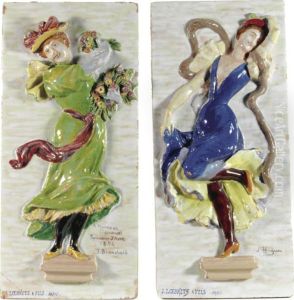Jules Blanchard Paintings
Jules Blanchard, born on February 25, 1832, in Puiseaux, France, was a notable French sculptor associated with the academic and neoclassical traditions of the 19th century. His full name was Jules Jean Baptiste Blanchard, and he came from a family with artistic inclinations; his father was a sculptor as well.
Blanchard received his initial training under his father's guidance before moving to Paris where he entered the École des Beaux-Arts. There, he studied under sculptor Armand Toussaint. Blanchard's talent was recognized early, and he was awarded the Prix de Rome in 1859, which granted him the opportunity to study at the French Academy in Rome, located in the Villa Medici. This experience allowed him to immerse himself in the study of classical sculpture and Renaissance works, which significantly influenced his artistic development.
Upon returning to France, Blanchard began receiving commissions that would establish his reputation as a master sculptor. He contributed to the embellishment of various public buildings and spaces, including the Paris Opera and the Hôtel de Ville. Among his notable works are the statues of Jean-Baptiste Colbert for the Hôtel de Ville and 'La Pêche' for the facade of the Louvre Museum. Blanchard's works were characterized by their detailed execution, harmonious proportions, and often allegorical nature.
In addition to public monuments, Blanchard was also known for his portrait busts and funerary sculptures. His works were regularly exhibited at the Salon, the official art exhibition of the Académie des Beaux-Arts in Paris, where he received several medals for his contributions. Blanchard's style evolved over the years, reflecting the shifts in artistic tastes, but he remained committed to the academic principles of clarity, order, and beauty.
Blanchard's career was marked by his appointment as a professor at the École des Beaux-Arts, where he influenced a new generation of sculptors. His legacy as a teacher and artist remained significant in the realm of French sculpture. He was also an officer of the Legion of Honor, a prestigious French order established by Napoleon Bonaparte.
Jules Blanchard passed away on January 19, 1916, in Paris. Despite the changing trends in art and the rise of modernism, Blanchard's work continued to be appreciated for its technical mastery and contribution to the decorative arts of his time. His sculptures can still be seen in various locations in France, serving as reminders of the rich artistic heritage of the 19th century.

